Surfing 101
How To Wipe Out Properly
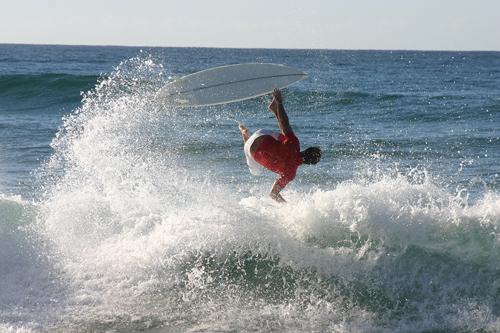 Hehehehehehehe wipe ooooout!! Those famous Beach boys lyrics have forever ingrained the word in our culture, but wiping out is serious business. Most of the bad things than can happen while surfing do so during a wipe out; injuries, broken boards, collisions and worse. There will be times when you are held under for longer than you like and other where you don't know which way is up. But there is actually a way to properly fall to help decrease the chances of something bad happening. Experienced surfers will do it out of reaction, but with a little bit of practice, you can wipe out properly as well.
Hehehehehehehe wipe ooooout!! Those famous Beach boys lyrics have forever ingrained the word in our culture, but wiping out is serious business. Most of the bad things than can happen while surfing do so during a wipe out; injuries, broken boards, collisions and worse. There will be times when you are held under for longer than you like and other where you don't know which way is up. But there is actually a way to properly fall to help decrease the chances of something bad happening. Experienced surfers will do it out of reaction, but with a little bit of practice, you can wipe out properly as well.
Why Wiping Out Properly Matters
You might be asking why wiping out properly when surfing matters. If you've just started surfing, or been lucky enough to make it a while without any mishaps, here is the 411. Like we mentioned before, most of the injuries, broken boards and collisions happen during a wipe out. In small waves between 2-4 feet the risks aren't that high, but the bigger the waves get, the greater the chances something bad will happen. Some of the worst things that can happen include:
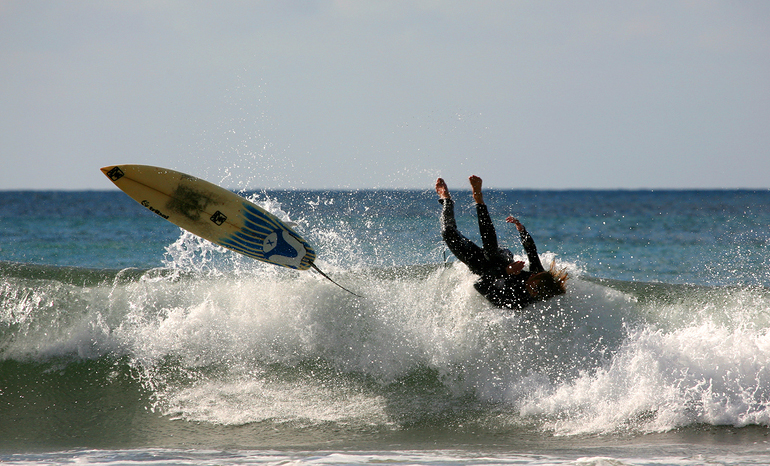 Dings: If your board hits you, the bottom or another surfer, there is a good chance you will end up with a ding. Though fixable, it might take your board out of commission for a few weeks.
Dings: If your board hits you, the bottom or another surfer, there is a good chance you will end up with a ding. Though fixable, it might take your board out of commission for a few weeks.
Broken Boards: The lip of the wave carries a lot of power. Most boards that break do so because of the lip, not because of hitting the bottom.
Broken Neck: If you hit the bottom head first, you run a risk of ending up unconscious or paralyzed. The surfer In Figure 2 is not in good situation as they will enter the water head first as the wave dumps on them.
Cuts & Gashes: Boards can cut you. Fins are sharp and the nose of shortboards can puncture skin. Not to mention that if your board snaps, there will be jagged edges and sharp exposed fiberglass.
Hitting Other Surfers: This can result in any of the above scenarios happening to you and another surfer. This can also result in the other surfer getting angry that you dinged their board.
Drowning: The worst case scenario. Though not common thanks to the hard work of lifeguards around the world, there are still surfers that loose their lives to the ocean.
Thing To Keep In Mind When Wiping Out
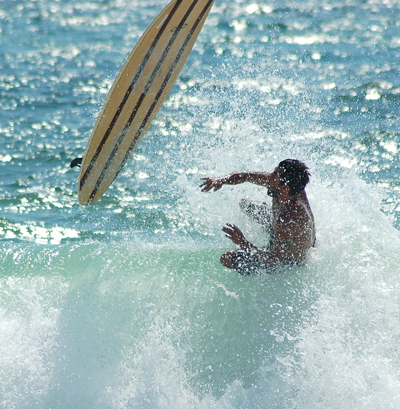 What Is On The Bottom: If you're surfing a sandy beach, you can push off the bottom but if you're surfing a reef, you have to be careful of sharp edges and cracks in the rock that can catch your ankle.
What Is On The Bottom: If you're surfing a sandy beach, you can push off the bottom but if you're surfing a reef, you have to be careful of sharp edges and cracks in the rock that can catch your ankle.
Where Is My Board: You always want to know where your board is. If it is between you and the wave, look out because the wave will catch it and push it at you. The surfer in Figure 3 is keeping their eyes and hands focused on protecting themselves from their falling board.
Where Are Other Surfers: If there are other surfers close to you, their bodies and boards also become something that can hit you. Keep your eyes open as you surf at all times so you are never unaware.
What Other Obstacles Are There: Rocks, piers, rip currents, cliffs and other factors can effect what the best course of action is. Most of the time you will not have to deal with many of these, but familiarity with your surf spot will help you be prepared. Before surfing at a new spot, ask a friend what to look out for or spend 15 minutes observing the break to become familiar. You won't regret it.
Wiping Out Properly
Step 1: Jump Away From Your Board
If you know you're going to fall, use your last bit of balance to jump away from your board. The best place to jump is towards or over the wave. Never jump in front of the board, or you will risk it hitting you in the head. A good way to jump is to go straight off the back of the board. As long as no one is in front of you, you can even push your board towards the shore to get it away from you. One of the best spots to aim for is the whitewater. Because it is churning, your impact is braced by the opposing forces of the water.
No matter where you jump or even if you just fall, always use one hand to block the surfboard from hitting you. Keep your arm extended towards it so you can push it away if it bounces towards you.
Step 2: Jump Shallow
Whether you jump or fall off your board, always do so like you are jumping into a shallow pool, not the deep end where the diving board is. Sometimes you will think it is deep but really the ground is only two or three feet below you. If you jump expecting it to be deeper you can sprain an ankle or even cut yourself on rocks along the bottom. Jump shallow and protect yourself.
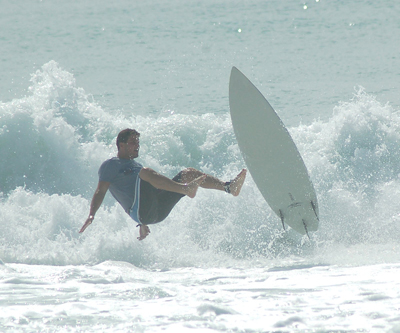 Step 3: Go Butt First
Step 3: Go Butt First
The best way to enter the water is on your butt like you're doing a cannon ball. By having your legs bent you minimize the chances of spraining an ankle on the bottom. If you are going to hit something like a rock, why not make use of the extra padding on your rear. There are other ways to hit the water, but whatever you do DO NOT GO HEAD FIRST!!! If your head hits something you might black out, so make sure it isn't leading the charge.
The surfer in Figure 4 is entering the water butt first. This is a great example of proper wipe out technique.
Step 4: Cover Your Head
Like I just said, your head is important and most people don't surf with a helmet. When you're underwater spinning, use your arms to cover your head. You can use one arm or both, but make sure you're protected.
Step 5: Stay Calm
Sometimes it feels like you've been underwater for a while, but you'll be surprised how long you can actually last holding your breath. Panicking only makes things worse for you so stay calm. Don't fight against the wave too much because that uses more oxygen, instead relax a bit and let the wave pass. Sometimes it will tumble you around a bit but it never lasts for too long.
Step 6: Get Low
If you've ever played around in the waves, you'll know that it is calm around the floor. The waves and white water do a lot of moving on the surface, but the lower you are, the less movement there is. Let yourself sink a bit and you will sometimes find you pass right under the wave. Of course, always make sure you know what is below you before doing this.
Step 7: Open Your Eyes
Most of the time the water is pretty clear. If you open your eyes, you will see what is around you which will make things much easier.
Step 8: Come Out Slowly
You might want to jump up quickly to get air, but if your board is right above you, you'll be looking at a nice bruise. You never know what is above you, it could be another surfer or their board. Come up slowly and keep one arm above you just in case.
Step 9: Get Your Board Quickly As soon as you are back up, get your board under control. You don't want it flopping around at the end of the leash where it might hit someone. You can either swim to it, or do what I do which is pull your leash. Get on your board, survey the situation and paddle away from any other break waves or surfers.
Step 10: Relax & Evaluate
Once you have gotten on your board and are away from any other breaking waves or surfers, take a second to catch your breath. Think about what you did well and what you can improve on. Try and recall how it felt so that next time you are under water, you can think back to this moment and remember that even if it feels like you're being held under water, you'll pop back up eventually. If there are any parts of your wipe out you think you can improve, don't worry, because I promise you'll have plenty of other chances to practice.
Conclusion
Wiping out properly while surfing can save you a major headache in more ways than one. The key is to remain calm and always be familiar with your surroundings. The ocean is powerful but if you respect it, she will reward you with experiences like nothing else.
Have you ever had a bad wipe out? Leave a comment below with your story and what you learned from it.



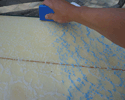
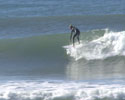
16 Comments